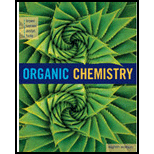
Interpretation:
The mechanism of the reaction given in the question has to be given.
Concept Introduction:
Cross coupling:
A cross coupling reaction is defined as a reaction that creates a
In the case of palladium catalysed cross-coupling reactions the other metal or metalloids are commonly
Stille coupling:
The
Trending nowThis is a popular solution!

Chapter 24 Solutions
ORGANIC CHEMISTRY-OWL V2 ACCESS
- When treated with NBS, the molecule below can form two different isomers of product. Provide the two products and a mechanism that accounts for the formation of each.arrow_forwardProvide a mechanism for the intramolecular nucleophilic addition and elimination reaction shown here by providing the missing structures (including the final product) and curved arrows. The reaction resembles a Dieckmann condensation, except instead of two esters, the molecule contains an ester and a ketone. The ketone is more acidic and will be the nucleophile. Your structures should include all nonzero formal charges and lone pairs of electrons. When drawing the enolate place the negative charge on the carbon not the oxygen.arrow_forwardGive detailed mechanism Solution with explanation needed...don't give Handwritten answerarrow_forward
- For each of the questions below – determine whether the following combinations of reactants, will react by substitution (SN1 or SN2 mechanism), elimination (E1 or E2 mechanism) or will not react under the conditions given. draw the final structure and explain the logic for each decision. There may be multiple possible options for some reactions. You must include all 4 aspects of these reactions, substrate, nucleophile, solvent and leaving group in the decisionarrow_forwardusing your knowledge in hydrocarbon chemistry, propose a reaction to convert 1-pentene into at least 6 other branched hydrocarbon compound that are consisting of 6 carbon atoms or more in their structure. write complete mechanism and steps. show all assumptions if any. you may use one or direct reaction or a combination of reaction to produce each product.arrow_forwardChoose one base, and conditions for the reaction to include temperature (low heat vs high heat) and specific solvent would be most suitable to promote the following alkyl halide to undergo an E2 mechanism. Draw the mechanism including hydride/alkyl shifts, intermediates, and ALL transition states as applicable. Draw products indicating the regiochemistry indicating the Zaitsev/Hoffmann products as well as stating which will be the major and which the minor product. Base: Solvent: Temperature: Mechanism:arrow_forward
- As some of you textbooks say most have seen while reading/ watching outside sources, that SMI and El occur on 2° carbons (we said they only take place on 3°). Let's explore that concept we didn't learn. Draw the SNY and El product for the following reaction and assume that it will go through a car bocation intermediate. Using your knowledge about car bocations, draw the product to the SMI and El reactions, and draw the mechanism of each of these reactions, explaining how you got to each of these products Lenna 12₂0 substitution Products Mechanism for substitution product Mechanism for elimination product Elimination Productarrow_forwardIn Section 12.2, we learned that the Simmons-Smith reaction produces a cyclopropane ring from an alkene. Diiodomethane (CH,I2) is treated with a source of zinc to produce the Simmons-Smith reagent (ICH,ZnI), which reacts with the alkene in a single elementary step. Complete the mechanism below by adding the necessary curved arrows for this elementary step. Hint: The curved arrow notation is very similar to that for epoxidation involving a peroxyacid.) H, CH2 Enantiomer + Simmons-Smith reagentarrow_forwardComplete the mechanism for the formation of the major species at equilibrium for the reaction of butanal in methanol solvent and catalytic aqueous acid. Make sure to include any missing atoms, bonds, charges, nonbonding electrons, and curved arrows.arrow_forward
- Chlorine and bromine react in the dark with alkenes. The reaction shown below affords a single major product as a racemic mixture. For the mechanism step below, draw curved arrows to show electron reorganization. Consider the formation of just one of the product stereoisomers. I am not sure if I have the arrows correct in this reaction: (see picture)arrow_forwardSpiropentane, shown on the left, reacts with Cl2 in the presence of light to furnish the two products shown on the right. Given that Cl2 is readily cleaved by light, provide a detailed step-by-step mechanism for the formation of the two products from the common intermediate shown in brackets, and also show the mechanism for the formation of the common intermediate from spiropentane. Use curved arrows to detail electron flow. Cl lo Cl2 + hvarrow_forwardConsider the molecule given below. In theory, there are only two inequivalent hydrogens in this molecule that could be substituted by Br in a free radical bromination – circle them. Put an asterisk to mark the one most likely to be substituted first. However, there are 5 possible products from free radical bromination. Draw all the products and show using arrow formalism how the intermediate radicals leading to these products formedarrow_forward
 Organic ChemistryChemistryISBN:9781305580350Author:William H. Brown, Brent L. Iverson, Eric Anslyn, Christopher S. FootePublisher:Cengage Learning
Organic ChemistryChemistryISBN:9781305580350Author:William H. Brown, Brent L. Iverson, Eric Anslyn, Christopher S. FootePublisher:Cengage Learning Organic Chemistry: A Guided InquiryChemistryISBN:9780618974122Author:Andrei StraumanisPublisher:Cengage Learning
Organic Chemistry: A Guided InquiryChemistryISBN:9780618974122Author:Andrei StraumanisPublisher:Cengage Learning


